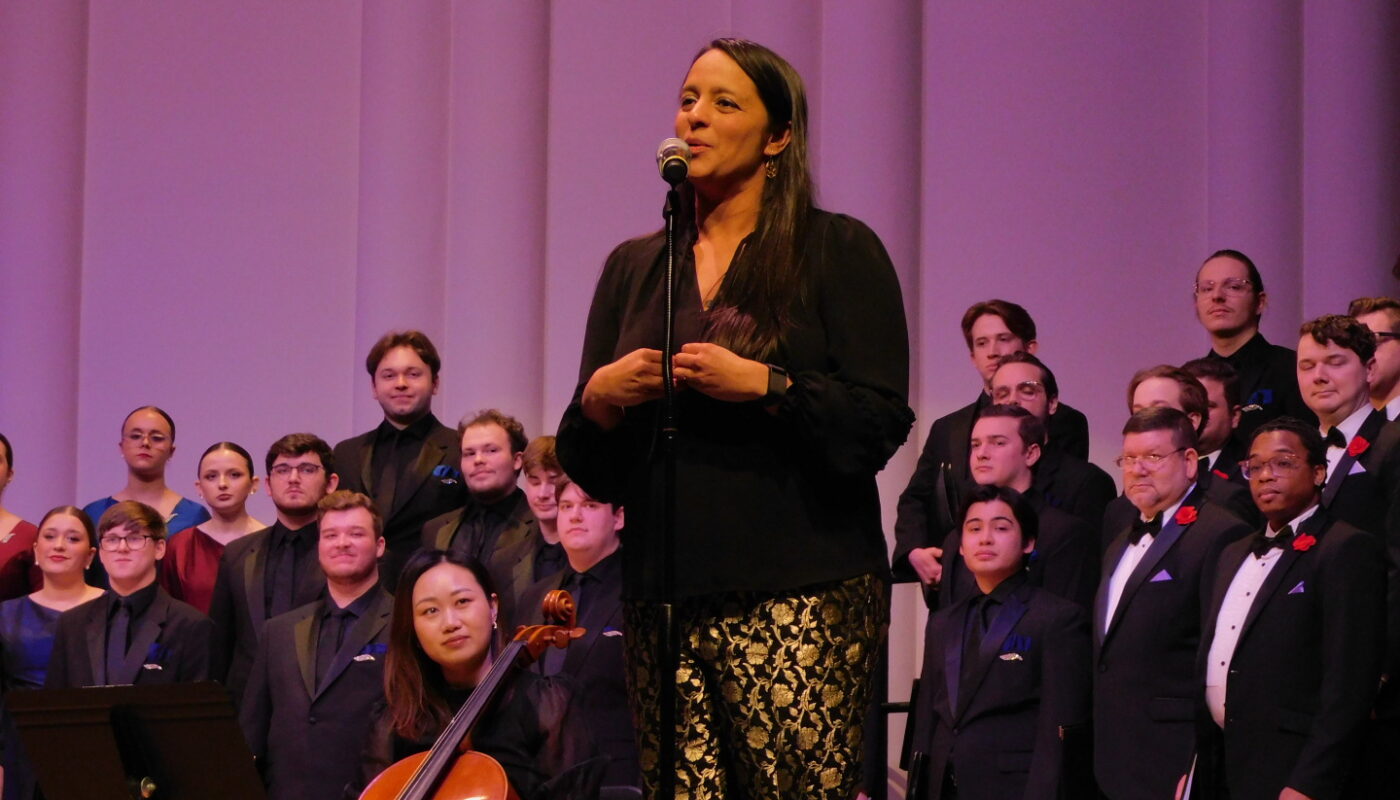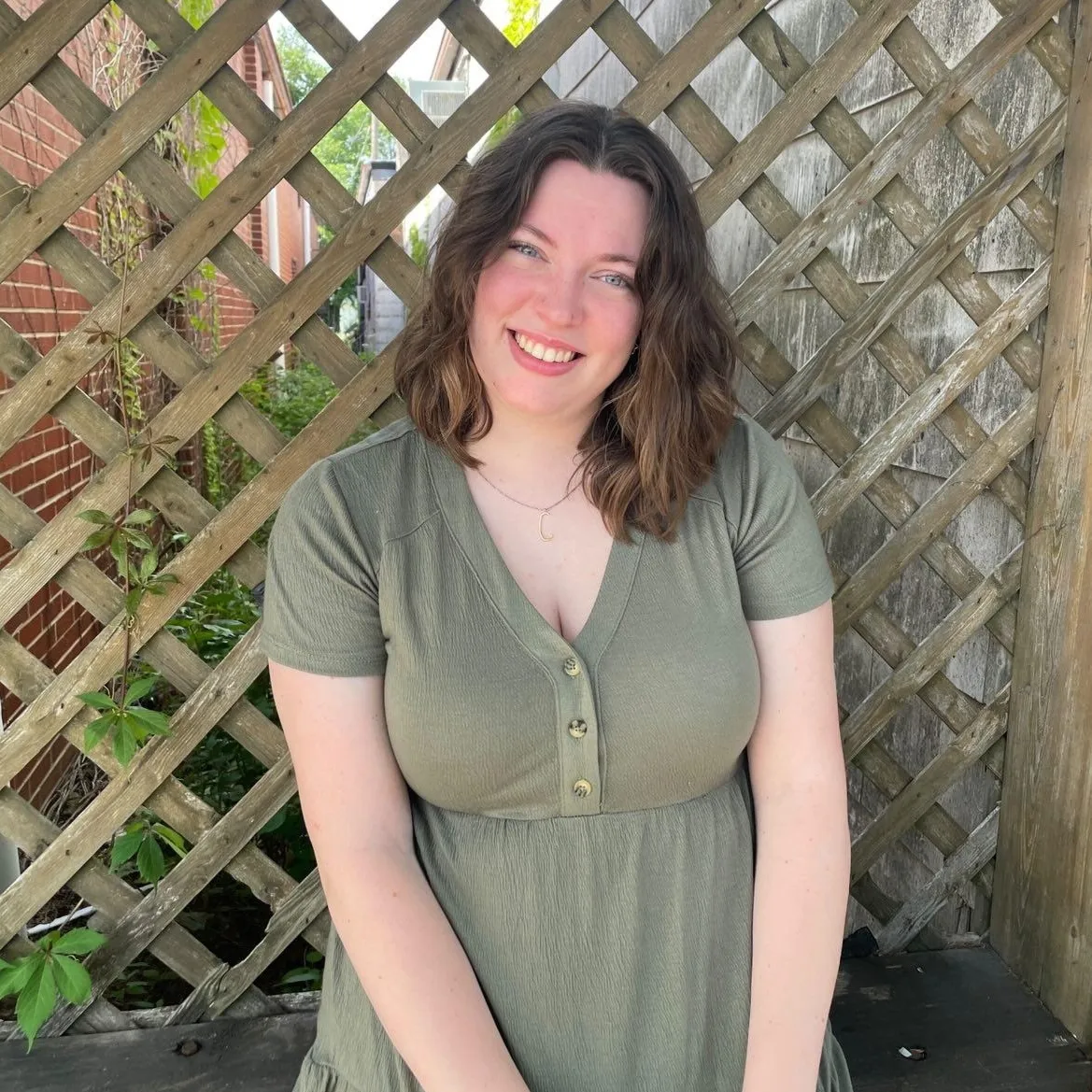Composer-in-Residence Reena Esmail urged listeners to create meaningful relationships through music. Every person asks of the other, “please hold my heart carefully.” Pictured is the Capital University Chapel Choir, Choral Union and cellist Mingyao Zhao.
Photo by Charlotte Keller
Musical innovation is constant, just like the events during the university’s annual NOW Festival, which boasted a week of concerts, collaborative workshops and improvisational and set concert performances.
The university’s guest composers are trailblazers within their fields: Reena Esmail, Aaron Quinn and Rocky Reuter.
Reena Esmail is a celebrated composer trained in both Western and Hindustani classical styles across a variety of mediums.
“Last year’s festival was primarily small groups chamber music,” said Associate Professor Tony Zilincik, so “the choral groups and the wind ensembles, the big band and choirs” were not as involved.
This year, because of Esmail’s range, “we were able to have her music on three of the nights in completely different places, which is excellent.”
“Music moves forward, and musical styles, musical tastes, musical industry, moves forward,” said composition and theory professor Dr. Dina Lentsner. “It’s always in motion, and we can’t always predict it. Emotion is what drives the musical expression.”
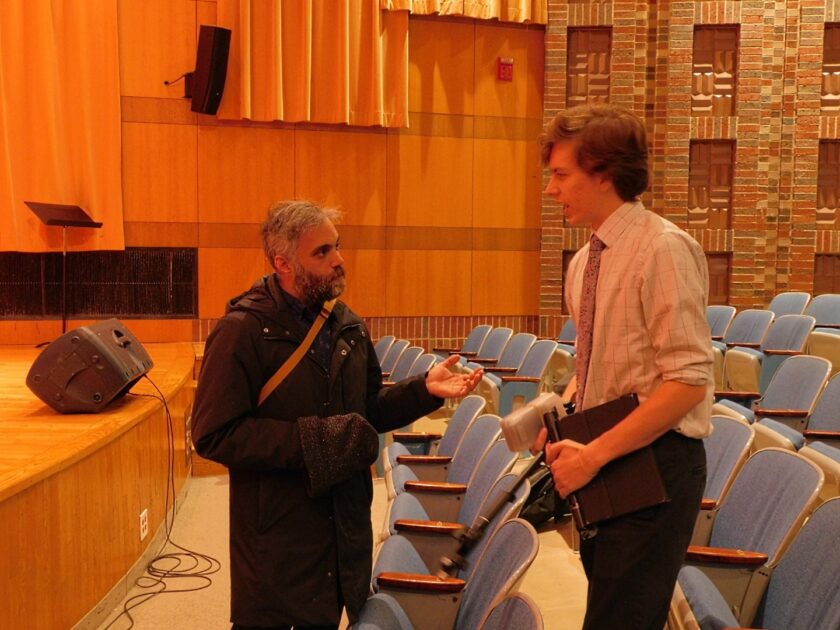
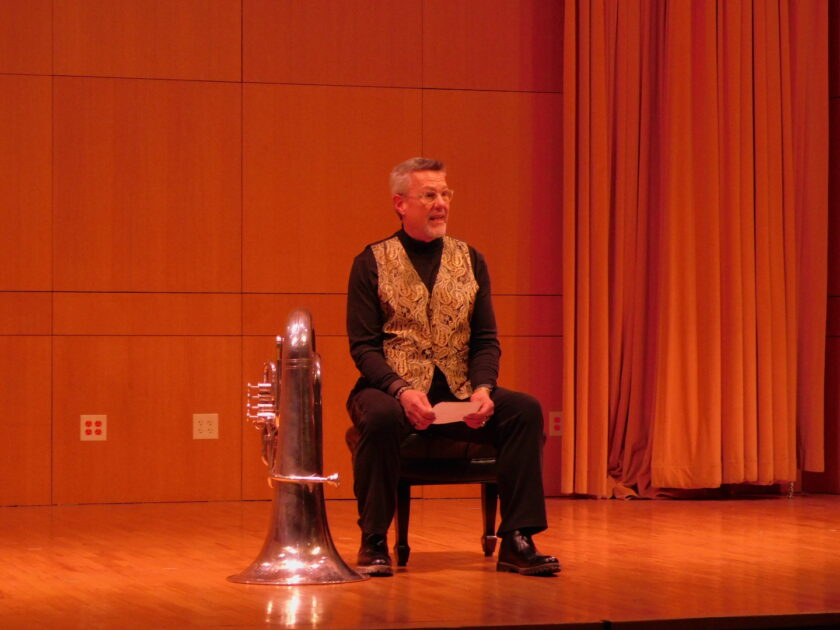
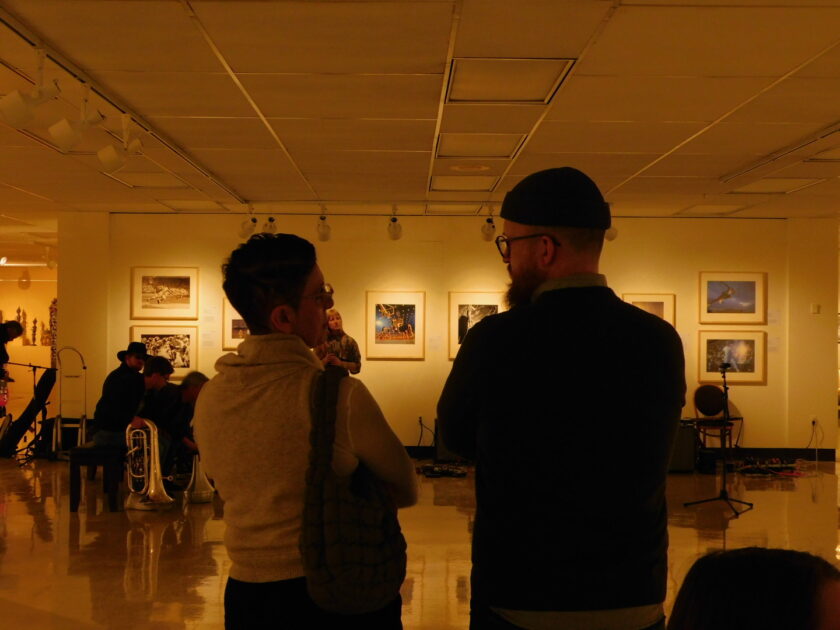
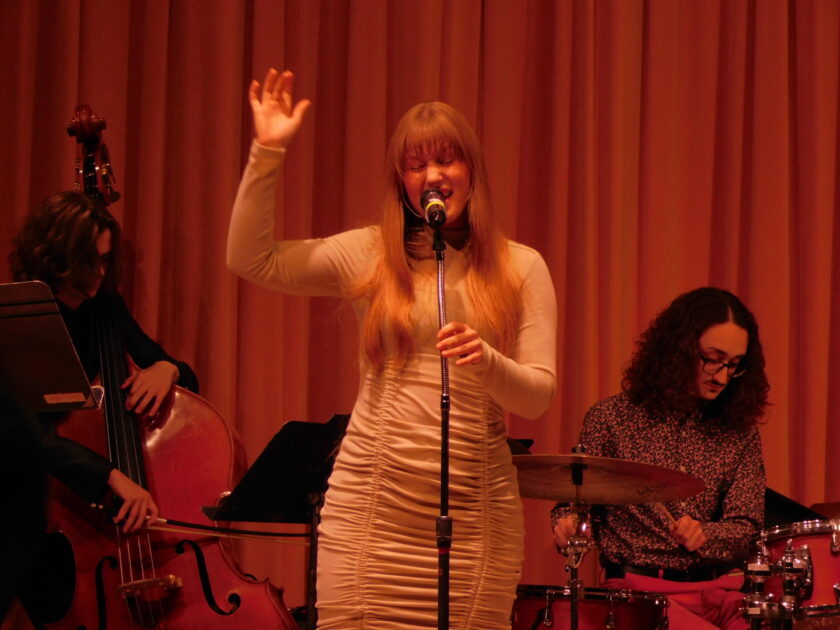
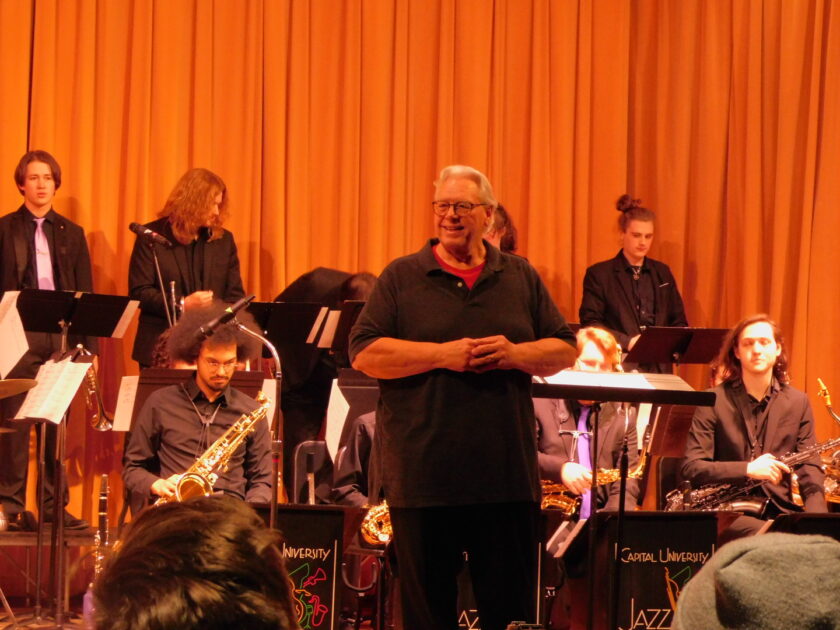
Esmail’s history of training in Western classical music, followed by Indian classical music in her twenties, has encouraged her to spend the majority of her career connecting the two.
“Here in academia, we are a bit disconnected from the down-to-earth everyday business of music making and connecting with people,” said Lentsner. Esmail can speak the language and share her composition with people of different backgrounds and demographics.
“I didn’t quite predict that the world would suddenly become so small and people would become so interested in other cultures,” said Esmail. “And I’m glad for it, because also, the Indian population has grown hugely since I was growing up.”
During her university residence, she stopped by Bexley High School and met a student who is Gujarati, like her.
“She shares my heritage, and I was telling her about this folk song that I was setting to music, and she knew the folk song, and so that would have never happened in my generation,” said Esmail.
Esmail said she previously felt like the representative of Indian music wherever she went. While being the representative is an honor, Esmail felt a heavy responsibility for the entire musical culture. However, this is changing.
“Whenever I see someone else who’s really doing things well, or really invested in Indian culture, who’s also invested in music, it makes me so happy to see that things are growing,” said Esmail.
Esmail often puts established texts, in both English and Hindi, to music, as opposed to writing her own lyrics: “Occasionally I will write my own text, and it’s only been a few times, usually for younger groups, where I feel like the music and the text has to be very intertwined.”
“There’s something that’s very important, not necessarily to say to young people, but to have young people say,” said Esmail. Because younger people take longer to learn music, “that means they’re going to internalize that message. And so what you say has to be so succinct and so meaningful that it kind of goes into them.”
When introducing a string quartet she composed, Esmail cited a meditator named John Kabat-Zinn and the book, “Wherever You Go, There You Are,” explaining the truth in the statement, as no matter how much someone tries to escape themselves, it’s never possible.
“We are always trying to be deeply, deeply present. So each piece,” said Esmail about the quartet, prompts us to “yearn, release, expand, connect, billow, receive. you’re expanding, connecting. You kind of reach out and connect to one another. And each of these little vignettes is a way to explore those relationships.”
“I’m looking for new things that I haven’t explored, whether they’re, you know, between Indian or Western music,” said Esmail, “or more largely, I think a lot about relationships in my music. And so I think… what relationships do I want to establish, and how can I use music to establish those relationships?”
This was the second year in a row “we celebrated women composers’ backgrounds. Reena’s parents are double immigrants… And last year, our guests came from the war zone, and it makes it very special for me,” said Lentsner, “because we join the community who stands for equality and celebration of achievement.”
Another one of her pieces is a Hindustani text made out of a series of three poems, ‘Chuti Hui Jagah’ or ‘The Space Between,’ by Manav Kaul. The first, ‘Joota,’ translates literally to ‘Shoe,’ referencing how people get blisters from their shoes and how it is similar to feeling the feeling of time passing.
Esmail “wanted to absorb the music that is part of her background. But she didn’t grow up with that… so she learned as an adult,” said Lentsner. “She chose the path of multicultural dimension music for as Hindi is a functional use.”
Zilincik explained that Esmail’s focus on heritage in her music is influential to students. This serves as a reminder that heritage can, and should, be part of music.
Esmail introduced one of her final pieces with an anecdote about feeling moved by text to nurture creative relationships.
“We’re trying to guard ourselves from things that are very difficult, but we’re also guarding ourselves from care. And so when the word begins to open, it can start singing. It can also accept the song.”
Esmail said she loves doing university residencies because of the investment and energy students bring to the table. She cites their joy in the music space as something that draws her in.
“This choir, this band, all these musicians that I’ve been meeting, they’re bringing their all to this music,” said Esmail. “And so when you see life breathe into your creations in that way. I mean, it’s just irreplaceable.”
University alumnus and jazz guitarist Aaron Quinn, who graduated in 2008, studied under Professor Stan Smith, and currently lives in Brooklyn. According to Zilincik, a coordinator of the festival, Quinn is one of the most up-and-coming musicians in jazz improvisation and composition.
“He is just a really unique voice. And it’s lovely, because he came from Capital and we were one of the stops on his journey of finding this very unique voice of his,” said Zilincik.
Quinn expressed his appreciation for the university and how it shaped him as a musician: “All of us were really bad and finding our way and pushing each other.”
The NOW festival “shows you can be honest in your intent,” said Quinn. Quinn attended these events every year of his undergraduate experience, even quitting his job at the time to attend concerts.
Quinn’s and Esmail’s works blend together by pushing boundaries of what is possible in academic performance and composition: “It was great to couple these two really, seemingly disparate things, but they’re but they’re not. They’re just different ways to create music,” said Zilincik.
“There are no genres. Everything can be made with no bias,” said Quinn. “All music is wiggly air.”
Professor Emeritus Rocky Reuter, founder of the NOW Festival, spent 30 years of his career at the university and has attended this celebration of art every year since its conception in 1987.
“I learned that a former dean… had started a contemporary festival, and was bringing in the 1970s a lot of very big names in composition,” said Reuter. “It’s always been a marriage of all ages of composers, all styles of music. And it’s a lot of fun to come back and still see it all going on.”
The university describes the NOW Festival as “eclectic in nature, covering a diverse range of compositional and performance styles,” which exposes the campus community and beyond to sounds and ideas they have never thought possible.
The improvisational component was paired with the latest installation in the Schumacher Gallery on the fourth floor of the Blackmore Library, ‘The Perfect Shot: Walter Iooss Jr. and the Art of Sports Photography.’
The event, entitled ‘Art in (e)Motion,’ was just one of the many explorations of different art mediums coming together to expand cultural understanding.
One of the features of the week is experiencing live premieres of pieces by university faculty, students and alumni, including both Zilincik and Lentsner.
Of her latest piece for wind ensemble, Lentsner said “I just decided to write honestly: not economic, emotional. It was guided by my emotion rather than my intellectual process that I usually go through when I write music.”
Lentsner wanted to connect to the musicians and the audience through feeling, which is different from her typical thinking.
“The goal is to write beautiful, at least one beautiful melody — very warm and lyrical harmonies,” said Lentsner.
This week of concerts is not only valuable for the Conservatory of Music students, but to all students who, after engaging with this music and art, will “learn about a culture, and then they are more worldly, and they’re out of their lane, you know, even if it’s for a couple of hours,” said Zilincik.

